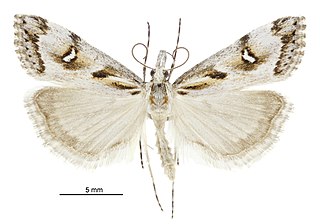
Amblyptilia epotis is a moth of the family Pterophoridae. It is endemic to New Zealand and is found in the South and Stewart Islands. It inhabits mountainous terrain covered in alpine vegetation or alternatively alpine wetland habitat. The adults of this species are on the wing from February to March. In appearance the adults of this species are variable in colour however this species can be distinguished from similar species by the oblique apical streak on its forewings as well as the patch of white on the costa cilia towards the apex of the forewing.

Gadira leucophthalma, the beaked moss moth, is a moth in the family Crambidae. It is endemic to New Zealand. It is found in the south eastern side of the South Island down to Banks Peninsula. G. leucophthalma inhabits the foredunes of coastal areas. The larval host is unknown but it has been hypothesised that the larvae feed on moss. The adult moths are day flying although some specimens have been trapped at night via light traps. Adults are commonly on the wing from March to April. This species has been classified as Nationally Vulnerable by the Department of Conservation.
Habrona papuata is a moth in the family Drepanidae. It is found in Papua and Papua New Guinea, where it has been recorded from mountainous areas.
Agonopterix oregonensis is a moth in the family Depressariidae. It was described by John Frederick Gates Clarke in 1941. It is found in North America, where it has been recorded from California to southern British Columbia.

Agonopterix argillacea is a moth in the family Depressariidae. It was described by Thomas de Grey in 1881. It is found in North America, where it has been recorded from California to British Columbia and in Manitoba, Ontario, New Brunswick, Nova Scotia, Michigan, South Dakota, Illinois, Texas, Florida and Utah.
Depressaria angustati is a moth in the family Depressariidae. It was described by John Frederick Gates Clarke in 1941. It is found in North America, where it has been recorded from Washington.
Depressaria eleanorae is a moth in the family Depressariidae. It was described by John Frederick Gates Clarke in 1941. It is found in North America, where it has been recorded from Alberta, Ontario and in Maine.
Depressaria whitmani is a moth in the family Depressariidae. It was described by John Frederick Gates Clarke in 1941. It is found in North America, where it has been recorded from California, Arizona, Washington, Colorado and Montana.
Depressaria cinereocostella is a moth in the family Depressariidae. It was described by James Brackenridge Clemens in 1864. It is found in North America, where it has been recorded from Manitoba, Nova Scotia to Georgia and in Nebraska.
Depressaria juliella is a moth in the family Depressariidae. It was described by August Busck in 1908. It is found in North America, where it has been recorded from Washington, Oregon, Wyoming, Utah and New Mexico.
Exaeretia hildaella is a moth in the family Depressariidae. It was described by John Frederick Gates Clarke in 1941. It is found in North America, where it has been recorded from Alberta and the Northwest Territories.
Exaeretia thoracenigraeella is a moth in the family Depressariidae. It is found in North America, where it has been recorded from California and Oregon.

Dactylethrella bryophilella is a moth in the family Gelechiidae. It was described by Walsingham in 1891. It is found in the Democratic Republic of Congo (Equateur) and Gambia.
Dichomeris xerodes is a moth in the family Gelechiidae. It was described by Walsingham in 1911. It is found in Mexico (Tabasco).
Dichomeris habrochitona is a moth in the family Gelechiidae. It was described by Walsingham in 1911. It is found in Panama.

Chionodes obscurusella, the boxelder leafworm moth, is a moth in the family Gelechiidae. It is found in North America, where it has been recorded from Nova Scotia to Manitoba, south to North Carolina and Oklahoma.
Antaeotricha superciliosa is a moth of the family Depressariidae. It is found in French Guiana and Brazil.
Eupselia theorella is a moth in the family Depressariidae. It was described by Edward Meyrick in 1880. It is found in Australia, where it has been recorded from New South Wales.

Tingena ancogramma is a species of moth in the family Oecophoridae. It is endemic to New Zealand and has been found in the Hen and Chicken Islands, the North Island and the South Island. Adults are on the wing in summer and autumn and inhabit open areas of forest scrubland.

Trachypepla spartodeta is a moth of the family Oecophoridae first described by Edward Meyrick in 1883. It is endemic to New Zealand and has been collected in both the North and South Islands. This species inhabits native forest and adults are on the wing from November to January.






